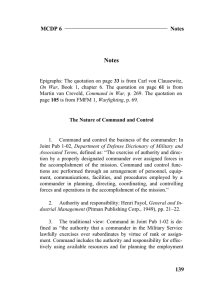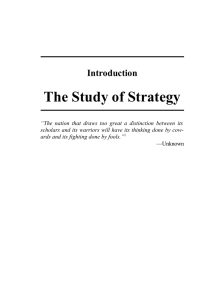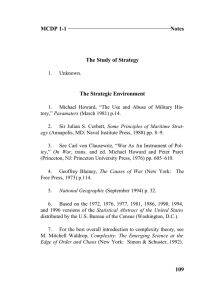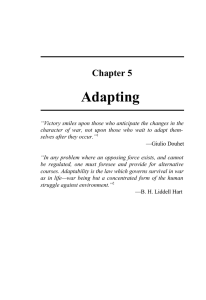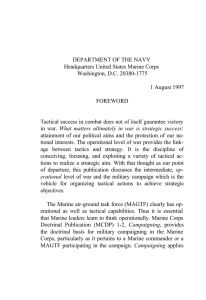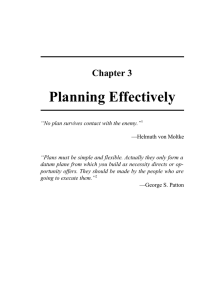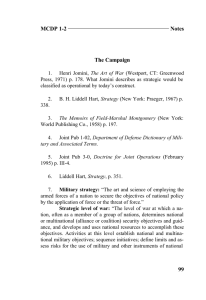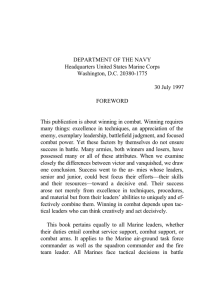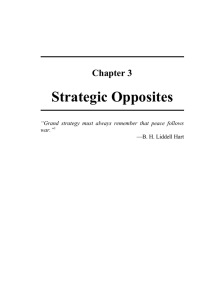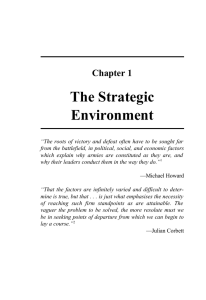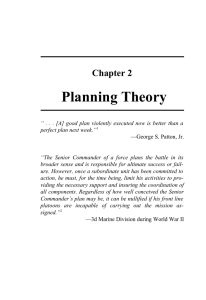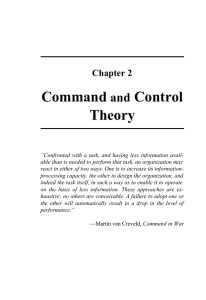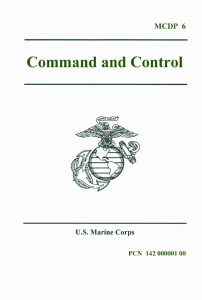The Nature of Planning Chapter 1
advertisement
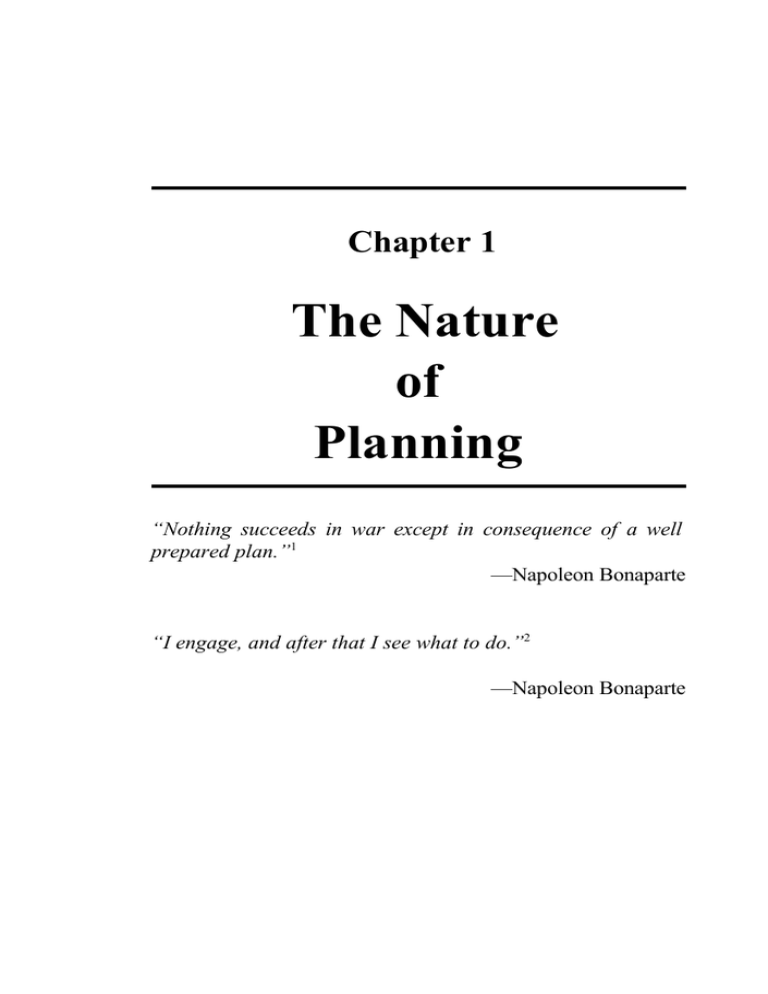
Chapter 1 The Nature of Planning “Nothing succeeds in war except in consequence of a well prepared plan.”1 —Napoleon Bonaparte “I engage, and after that I see what to do.”2 —Napoleon Bonaparte MCDP 5 The Nature of Planning T o plan effectively, we must first appreciate the fundamental nature of planning and plans. We must understand the purpose, environment, and characteristics of the process as well as the object and traits of its product. This understanding will become the basis for developing a theory and practical philosophy of planning. PLANNING AND PLANS DEFINED Planning is the art and science of envisioning a desired future and laying out effective ways of bringing it about.3 It is a preparation process. Here we draw an important distinction between a process (a dynamic system of related activities) and a procedure (a prescribed sequence of steps for accomplishing some specified task). The planning process may often involve the use of procedures to perform certain tasks, but planning overall is too complex and situation-dependent to be treated as a routine procedure. Planning is also distinctly a process rather than merely an act because it involves a number of ongoing, iterative, and interdependent activities. Since situations (or the information available about them) continuously change, we must continue to adapt our plans as time allows. Planning is a process that should build upon itself—each step should create a new understanding of the situation which becomes the point of departure 3 Planning MCDP 5 for new plans.4 Planning for a particular action only stops with execution, and even then adaptation continues during execution. Planning encompasses two basic functions—envisioning a desired future and arranging a configuration of potential actions in time and space that will allow us to realize that future. Planning is thus a way of figuring out how to move from the current state to a more desirable future state—even if it does not allow us to control the transition precisely. Planning involves projecting our thoughts forward in time and space to influence events before they occur rather than merely responding to events as they occur. This means contemplating and evaluating potential decisions and actions in advance. It involves thinking through the consequences of certain potential actions in order to estimate whether they will bring us closer to the desired future. In war, this naturally involves trying to anticipate possible enemy responses to our actions. Planning also involves integrating these individual decisions and actions together into potential sequences and examining the possible implications of these sequences. We should think of planning as a learning process—as mental preparation which improves our understanding of a situation.5 In its simplest terms, planning is thinking before doing. Even if the plan is not executed precisely as envisioned—and few ever are—the process should result in a 4 MCDP 5 The Nature of Planning deeper situational awareness which improves future decisionmaking. We should thus think of planning as a learning activity that facilitates the exercise of judgment and not as merely a mechanical procedure. Generically, a plan is any product of planning. It may be a formal, articulated document or an informal scheme. Since planning is an ongoing process, it is better to think of a plan as an interim product based on the information and understanding known at the moment and always subject to revision as new information and understanding emerge.6 A plan is thus a structured configuration of actions in time and space envisioned for the future. A plan is the basis for action, cooperation, and adaptation. Most military plans are arranged hierarchically, as plans for one echelon are nested within the plans of higher echelons. THE VALUE OF PLANNING Planning keeps us oriented on future objectives despite the problems and requirements of the present situation. Nearly all military activities can benefit from some kind of planning. This is not the same thing as saying that planning should be done in every situation or that every problem requires a planned solution. The value of planning changes with every situation, with every type of activity, and with every level of an organization. 5 Planning MCDP 5 Some situations require extensive planning, and some none at all. We may succeed without planning, and we may fail with it. Planning is based on the belief that by intervening in events in the present, we can bring about a better future. If there were no way to influence the future, if we perceived that the natural course of events would lead to a satisfactory outcome, or if we believed we could achieve the desired results purely by reacting to the situation as it developed, there would be no reason to plan. There may be cases in which these conditions apply, but these cases are few indeed. The mere act of planning is not valuable in itself. Use of a prescribed planning procedure does not guarantee that we will improve our situation. Planning takes on value when done properly, using methods appropriate to the conditions and the activities being planned. Done appropriately and well, planning is an extremely valuable activity which greatly improves performance and is a wise investment of time and effort. Done poorly and inappropriately, planning can be worse than irrelevant and a waste of valuable time and energy. There are several reasons why proper planning is essential. First, planning can be essential to the ability to seize the initiative. In order to seize the initiative, we must be able to anticipate events and act purposefully and effectively before the enemy can. We must be proactive. This normally requires planning. Proper planning puts us in the position to be ready to 6 MCDP 5 The Nature of Planning act when necessary or advantageous and not merely to react to developments. Second, planning is essential to reduce the unavoidable time lag between decision and action on the battlefield, especially at higher levels. Acknowledging this time lag is not an excuse for acting sluggishly but simply a recognition of the reality of war. While some actions can be implemented immediately, others require forethought and preparation. For example, changing the direction of attack may be a relatively simple and immediate matter at the squad level, but changing the scheme of maneuver of a division, to include all its support, is a more complicated and time-consuming effort requiring greater preparation. Simply changing the priority of fires in a division can take considerable time if it is necessary to move artillery units. If we wait until an event materializes to begin to prepare for it, we may not be able to react quickly enough. Proper planning should help us reduce crises by dealing with situations before they reach crisis proportions. In many situations, prompt action requires advance thought and preparation. Third, planning is essential when situations reach a certain level of complexity. If a situation is simple enough, we can often devise a solution on the spot. When a situation is more complex, consisting of numerous interrelated activities and decisions, we may not be able to keep track of the various possibilities without working systematically through the prob- lem. One of the basic reasons for planning is to come to grips with 7 Planning MCDP 5 complexity. In general, the more complex the situation, the more important and involved becomes the planning effort. Finally, planning can be essential in novel situations in which experience is lacking. Part of the fundamental value of planning is that it can serve, at least in part, as a substitute for experience.7 When we are sufficiently experienced in a situation, we may know intuitively what to expect, what goals are feasible, and what actions to take. In situations in which we lack specific, first-hand experience, we may use planning to think through the problem systematically and devise a workable solution. CATEGORIES OF MILITARY PLANNING Military planning comprises two broad categories—force planning and operation planning. Force planning is planning associated with the creation and maintenance of military capabilities. It supports preparations for war and involves the planning necessary to recruit, organize, train, educate, equip, and provide military forces.8 Operation planning is planning for the mobilization, deployment, employment, sustainment, and redeployment of military 8 MCDP 5 The Nature of Planning forces to accomplish assigned missions. At the strategic level, operation planning involves the development of strategic military objectives, strategic concepts, and tasks in support of national security strategy. At the operational level, planning involves developing campaign plans to link the tactical employment of forces with strategic objectives. At the tactical level, planning involves developing objectives, concepts of operations, and tasks for the employment and sustainment of military forces in combat or noncombat military activities at a particular time and place. This publication will focus on operation planning, although the principles discussed apply in general to force planning. PLANNING TAKES MANY FORMS Within these two broad categories, planning covers a wide range of activities. In force planning, we design desired capabilities into military forces and units. We plan force structure, size, composition, and manning of units. We plan training by establishing training objectives, designing exercises and other training evolutions, and assigning training resources. We plan education from broad curriculum design to detailed lesson plans. We plan the research, development, testing, and fielding of new technologies. We plan manpower accessions. 9 Planning MCDP 5 In operation planning, we may plan strategically, operationally, or tactically. We plan in anticipation of contingencies that may or may not ever occur. We plan mobilization to assemble forces. We plan deployments to move those forces to the theater. We plan the employment of those forces in military evolutions. We plan the sustainment of forces to maintain their combat power. We plan the redeployment of forces at the end of hostilities or the completion of the mission. We plan in broad designs, producing outline plans which establish the salient features of the concept of operations as the basis for later detailed planning. We plan supporting functional activities such as aviation, intelligence, fire support, or logistics. We plan the necessary details of execution, producing landing plans, for example, which assign specific units to specific landing waves, or communications plans, which establish communications channels and assign frequencies. We plan with different time horizons, from long-range to midrange to short-range. Depending on the circumstances, we may plan in years, months, or weeks, or we may plan in days, hours, or minutes. Planning may involve an individual working through the process alone, or it may involve a commander and staff working together. The planning process may be informal—a squad leader developing a simple scheme of maneuver for an attack, for example. It may be more formal, involving specific procedures and responsibilities—as in the deliberate creation, evaluation, and articulation of a course of action. We may plan 10 MCDP 5 The Nature of Planning rapidly when time is short or deliberately when more time is available. Sometimes the activity to be planned is very specific and the goals very clear. At other times, planning must first determine what the activity and the goals are. Some planning results in extensive written orders complete with operation annexes.9 Other planning results in brief fragmentary orders issued orally. Thus, planning can mean different things to different people, to different organizations, or to different echelons within an organization. While almost any military activity involves some form of planning, there is no universal procedure or technique equally suited to all requirements. We must adapt the planning methods we use to the particular requirement we face. PLANNING AS COMMAND AND CONTROL Planning is an essential and significant part of the broader field of command and control. We can even argue that planning constitutes half of command and control, which includes influencing the conduct of current evolutions and planning future evolutions. The responsibility to plan is inherent in command, and planning supports practically every command function. In 11 Planning MCDP 5 other words, all commanders are planners.10 In fact, the commander is probably the single most important factor in effective planning. The commander disciplines the planning process so that it is sensitive to time, planning horizons, simplicity, and level of detail. The commander also disciplines the product to ensure the output is relevant to the moment and suitable to the subordinate. Since planning is part of command and control, the fundamental object of command and control is also the fundamental object of planning—to recognize what needs to be done in any situation and to ensure that appropriate actions are taken. Planning supports both aspects of command and control. It supports decisionmaking by helping to develop and evaluate potential courses of action, and it supports execution by identifying and detailing measures needed to implement the chosen course of action. As a rule, the higher the echelon, the greater the role of planning in the command and control effort. Some high-level headquarters perform command and control almost exclusively through planning and issuing plans. Like command and control, planning focuses on solving problems: identifying a problem (the difference between our current situation and the desired outcome) and preparing a tentative configuration of actions intended to achieve that outcome. Thus all planners are problem solvers. Furthermore, since planning is problem solving, then a plan is a practical scheme for solving a problem or set of problems. 12 MCDP 5 The Nature of Planning The object in planning is not merely to solve the problem in the near term, but to do so in a way that also lays the foundation for long-term success.11 The problem may be broad and conceptual, involving strategic or tactical issues, or it may be more detailed, involving the allocation or assignment of resources. Not all problem solving, however, requires planning. When the problem is simple, planning may not be necessary. When the problem is more complicated—involving a variety of factors—planning becomes essential. This is even more crucial when the problem is actually a complex set of interrelated problems, the solution to each of which affects all the others. If the situation is complex enough, planning may offer the only opportunity to deal with the complete set of problems as a whole. Command and control can also be viewed as the process of adapting an organization to its surroundings.12 Planning must therefore support adaptation. There are two basic ways to adapt. The first is to anticipate future requirements and prepare for them prior to execution. Anticipation permits us to adapt in a prepared, concerted way. Given the uncertainty of war, however, we cannot possibly anticipate every action. We must also be able to adapt to situations as they unfold. This second form of adaptation, sometimes called improvisation, simply means taking action that was not initially planned. It requires us to modify our plans in order to deal with unforeseen circumstances. The apparently contradictory quotations by Napoleon at the beginning of this chapter illustrate that both types of adaptation 13 Planning MCDP 5 are essential in war. In fact, they are complementary. The real difference between them is time: one occurs sufficiently in advance to allow for preparation while the other occurs in real time. Planning supports both types of adaptation. Planning is the primary means by which we anticipate requirements and adapt to them in advance. We can thus think of planning as anticipatory adaptation. Planning also supports adaptation in execution because even when we take unplanned action, we rarely act without any preparation at all. Instead, we adjust from an existing scheme based on a common understanding of the situation and the expected result. Thus, the plan, even if not executed as designed, provides the point of departure for later unplanned action. Finally, we note that since decisionmaking is central to command and control, planning must contribute to effective decisionmaking. In this respect, we can also think of planning as anticipatory decisionmaking—tentative decisions made before the need to act. In this sense, a plan is a system of interrelated decisions subject to revision, and decisions are plans put into effect. The decisions may be broad and conceptual regarding which objectives to pursue or what tactics to adopt, for example, or they may be detailed decisions about resupply rates or the scheduling of aircraft sorties. When decisions are simple or decisionmakers are highly experienced, planning may not be needed. It is when we face multiple decisions that must be 14 MCDP 5 The Nature of Planning integrated—as is the case in nearly all military evolutions—that planning becomes crucial. THE FUNCTIONS OF PLANNING AND PLANS Planning and plans accomplish several key functions.13 First, plans direct and coordinate action by instructing those within the unit what to do and informing those outside the unit how to cooperate and provide support. Plans are thus a principal means through which the commander exercises command and control. In this respect, plans help allocate scarce resources effectively and efficiently. Directing and coordinating action is perhaps the most obvious function of planning, and in some situations it may be one of the most important functions. However, it is not the only function of planning, and we can run into trouble by emphasizing this function too strongly to the neglect of others. Overemphasizing the directing and coordinating function of planning can lead to micromanagement. Under such conditions, if unexpected events occur which nullify the planned action, subordinates may have difficulty adapting. Second, planning develops a shared situational awareness. The process of planning itself should provide a common understanding of the nature of the problem and so support communication and cooperation. In other words, planning is a way of exploring the situation. Even if the understanding of that 15 Planning MCDP 5 situation is incomplete or not entirely correct—and most attempts to attain situational awareness will be both—the common understanding provides a basis for unity of effort. In this respect, planning helps commanders both with formulating their intent and in conveying that intent to their subordinates. Planning should help identify both opportunities and threats in advance and allow us to prepare for them. It should help identify centers of gravity and critical vulnerabilities, both friendly and enemy. It should help us avoid preventable mistakes (although we realize that some problems invariably will arise despite our best planning efforts). Third, planning generates expectations about how actions will evolve and how they will affect the desired outcome. As previously mentioned, planning can serve as a partial substitute for experience. Planning can provide perspective and confidence. Planning can help us establish plausible goals, estimate what we can reasonably expect to accomplish, identify problem areas, evaluate courses of action, and develop responses to contingencies through reasoning. By helping to generate expectations, planning can help us recognize when an action is failing to accomplish the desired result. Fourth, as we have already identified, planning supports the exercise of initiative. By helping us detect when expectations are not being realized, planning helps us identify the need to depart from the original plan. The plan provides the point of departure from which to adapt to the unforeseen. By providing a shared situational awareness and shared expectations, 16 MCDP 5 The Nature of Planning planning helps us to maintain harmony with others while adapting the plan and to properly interpret similar departures by others. This function is especially important in highly uncertain and changeable situations. Finally, planning shapes the thinking of planners. Planning can provide a disciplined framework for approaching problems. It provides coordinated and cooperative methods for solving problems in a group setting. The key is to adopt a method that provides helpful structure without restricting judgment and creativity. The experience of developing a plan can be a valuable preparatory exercise in itself regardless of whether the plan is actually implemented. This function is different from the others—but still important—because while all the other functions serve the needs of execution, this function serves the needs of planners. In some situations different functions will be more important than others. For example, under the pressure of time, a commander may use the plan to focus on directing the actions of subordinates rather than on building shared situational awareness. In some situations, different functions may actually be in conflict. For example, a plan that addresses numerous contingencies may add flexibility in directing the actions of subordinates but at the expense of initiative, shared awareness, and expectations. The important thing is to recognize the various functions of planning and to understand which functions are most important in any given situation. 17 Planning MCDP 5 TYPES OF PLANS Plans come in as many forms as planning does.14 Strategic plans cover the overall conduct of a war. Campaign plans cover a series of related military operations aimed at accomplishing a strategic or operational objective within a given time and space. Tactical plans generally cover the conduct of a single military evolution. Functional plans cover specific types of functions or activities, such as aviation, logistics, communications, surveillance, and so on. More specifically, a plan is a particular type of directive. In general, directives are the physical product of planning. A directive is any communication by which a commander establishes policy or orders a specific action.15 There are two basic types of directives—plans and orders. A plan is generally developed well in advance of execution and is not executed until directed or until specified conditions are determined to exist. A plan is based on explicit assumptions about the future. By comparison, an order carries with it the obligation of execution either immediately or at a specified time. A plan becomes an order when directed for execution. There are two basic types of combat plans. An outline plan or concept plan is a preliminary plan which outlines the salient features or principles of a course of action prior to the initiation of detailed planning. We use outline or concept plans to evaluate the feasibility of a course of action, to inform higher 18 MCDP 5 The Nature of Planning headquarters of our intentions, and to initiate planning at lower echelons. An operation plan is a plan for a single action or a series of connected actions to be carried out simultaneously or in succession. There are several types of combat orders. An operation order is a directive issued by a commander to subordinate commanders for the purpose of effecting the coordinated execution of an operation. An operation order is normally a formal document. A fragmentary order is an abbreviated form of an operation order, issued as needed, that eliminates the need for restating information contained in a basic operation order. Fragmentary orders are less formal than operation orders and are often issued orally. They are the type of directive used most frequently at lower echelons. A warning order is a preliminary notice of an order or action which is to follow. Its purpose is to allow subordinates as much time as possible to prepare for the contemplated action. An execute order is an order to subordinates that directs them to execute existing orders or plans and conveys guidance not provided in earlier instructions. UNCERTAINTY AND TIME: PLANNING FOR AN UNKNOWABLE FUTURE As it is with command and control, the defining features of the planning challenge are uncertainty and time. More than 19 Planning MCDP 5 anything else, considerations of time and uncertainty dictate our approach to planning. All planning is based on imperfect knowledge and involves assumptions about the future. All planning by definition is future-oriented, and the future by nature is uncertain. No matter how determined we are to be fully prepared for a situation, there are finite limits to our ability to plan for the future. The more certain the future is, the easier it is to plan. Uncertainty increases with the length of the planning horizon and the rate of change in the environment. Planning horizon refers to how far into the future we try to shape events. In order to be of any use, planning must try to anticipate and actively influence the future. By anticipating the future, planning allows us to prepare and coordinate our actions. The farther into the future we can plan, the more time we can allow ourselves to prepare. However, the farther into the future we plan, the wider the range of possibilities and the more uncertain our forecast. A fundamental tension thus exists between the desire to plan far into the future in order to facilitate preparation and coordination, and the fact that the farther into the future we try to plan, the less certain we can be, and the less relevant our preparations may be. Given the fundamentally uncertain nature of war, we must recognize that the object of planning is not to eliminate or minimize uncertainty, but to allow us to decide and act effectively in the midst of uncertainty. While all planning contains an 20 MCDP 5 The Nature of Planning element of forecasting, we must recognize that the object of planning is not to predict the future. How accurately a plan forecasts the future is not generally a measure of the plan’s effectiveness. Rather, the measure of effectiveness is how effectively planning allows us to adapt to an uncertain future. Not only is war fundamentally uncertain, it is always changing. Because situations change continuously, plans tend to lose their value over time, and they must be updated as the situation changes. The more frequently and quickly the situation changes, the more often a plan must be revised. Time becomes a precious commodity that both sides will attempt to exploit. The result is a more or less constant pressure to decide and act more quickly than the enemy. We must use available planning time wisely. All planning takes time, and we should realize that it may occur at the expense of tempo. However, this is not necessarily the case. Planning done well in advance of the need to act may actually permit us to act more quickly when the time for action arrives. COMPLEXITY: THE LIMITS OF FORESIGHT AND DESIGN All planning involves attempting to forecast and influence future development. Such efforts tempt us to believe we have 21 Planning MCDP 5 more control over the course of events than we do. We may mistakenly come to believe that the object of planning is to impose control over the events of the battlefield. Planning attempts to shape the future, yet war is an intrinsically chaotic phenomenon that denies precise, positive control over events. Clausewitz wrote, “Countless minor incidents—the kind you can never really foresee—combine to lower the general level of performance, so that one always falls far short of the intended goal.”16 Military problems simply are not amenable to engineered solutions. We can rarely expect to accurately foresee outcomes or precisely control developments in war, especially over long horizons of time. Since war is an interactive clash between independent wills, military situations are not one-sided problems, as are engineering problems. Even as we begin to develop a solution to a problem, the problem changes. Many military problems simply cannot be solved optimally, no matter how long or hard we may think about the problem beforehand. In many cases, the best we can hope to do is to devise partial, approximate solutions and refine those solutions over time, even after execution has begun. Planning is the process of contemplating future actions and their effects, but individual cause and effect are nearly impossible to isolate in a complex phenomenon like war. Actions in war, friendly or enemy, rarely have precisely the effect we anticipate. Moreover, war is not a single problem, but a complex system of interdependent problems, the solution to each of which affects the outcomes of all the others. 22 MCDP 5 The Nature of Planning Finally, further complicating all the above is the realization that resources will always be limited. This introduces the problem of making the most efficient use of available resources in an uncertain environment that defies optimization. It is only when we see planning within the context of the complex environment of war that we fully recognize it as one of the most challenging intellectual activities in which we can engage.17 PLANNING MISUSED Planning is an essential military activity. However, several common mistakes must be understood so that we can guard against them.18 These pitfalls generally derive from a common cause—the failure, or more often the willful refusal, to appreciate the unpredictability and uncertainty of war. Pointing out these mistakes is not a criticism of planning but of improper planning. Commanders must recognize both the benefits and the potential pitfalls of planning. It is the commander’s responsibility to ensure that planning is conducted properly to avoid these pitfalls. The commander disciplines the planning process and teaches the staff the relevance of product content. First is the mistake of attempting to forecast and dictate events too far into the future. In part, this may result from the 23 Planning MCDP 5 natural desire to believe we can control the future. It is a natural tendency to plan on the assumption that the future will merely be a linear continuation of present conditions, and we often underestimate the scope of changes in direction that may occur. Because we cannot anticipate the unexpected, we tend to believe it will not occur. Evidence shows that most plans are overcome by events much sooner than anticipated by the planners.19 Second is the mistake of trying to plan in too much detail. This is not a criticism of detailed planning but of planning in more detail than the conditions warrant. This pitfall often stems from the natural desire to leave as little as possible to chance. In general, the less certain the situation, the less detail in which we can plan. However, the natural response to the anxiety of uncertainty is to plan in greater detail, to try to cover every possibility. This effort to plan in greater detail under conditions of uncertainty can generate even more anxiety, which in turn leads us to try to plan in even more detail. The result can be an extremely detailed plan that does not survive the friction of the situation and that constricts effective action. Third is the tendency to use planning as a scripting process that tries to prescribe friendly and even enemy actions with precision. When planners fail to recognize the limits of foresight and control, the plan can become a coercive and overly regulatory mechanism that restricts initiative and flexibility. 24 MCDP 5 The Nature of Planning The focus for subordinates becomes meeting the requirements of the plan rather than deciding and acting effectively. Last is the tendency for institutionalized planning methods to lead to inflexible or lockstep thinking and for planning and plans to become rigid and overly emphasize procedures. We have mentioned that planning provides a disciplined framework for approaching problems. The danger is in taking that discipline to the extreme. It is natural to develop planning routines to streamline the planning effort. Insofar as they provide economy of effort and coordination among several people working on the same problem, routines can improve planning. In situations where planning activities must be performed repeatedly with little variation, it helps to have a well-rehearsed procedure already in place. Nevertheless, there are two dangers. The first is in trying to reduce those aspects of planning that require intuition and creativity to simple processes and procedures. Not only can these skills not be captured in procedures, but attempts to do so will necessarily restrict intuition and creativity. The second danger is that even where procedures are appropriate, they naturally tend to become rigid over time. This directly undermines the objective of planning—enabling the organization to become more adaptable. This tendency toward rigidity “must be viewed as one of the gravest pathological characteristics of planning and of plans.”20 25 Planning MCDP 5 CONCLUSION Planning is an essential part of command and control, helping us to decide and act more effectively. As such, planning is one of the principal tools the commander uses to exercise command and control. Planning involves elements of both art and science, combining analysis and calculation with intuition, inspiration, and creativity. To plan well is to demonstrate imagination and not merely to apply mechanical procedures. Done well, planning is an extremely valuable activity that greatly improves performance and is an effective use of time. Done poorly, it can be worse than irrelevant and a waste of valuable time. The fundamental challenge of planning is to reconcile the tension between the desire for preparation and the need for flexibility in recognition of the uncertainty of war. 26
